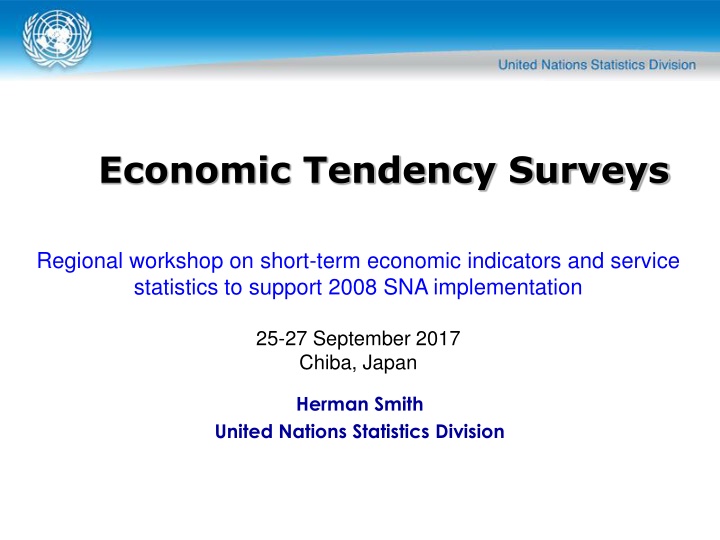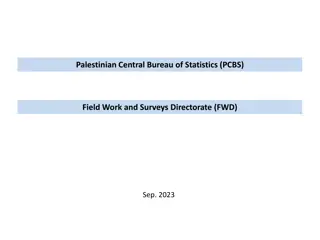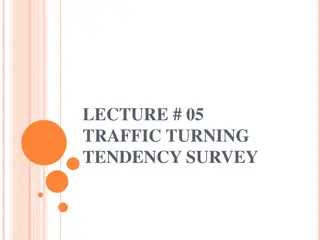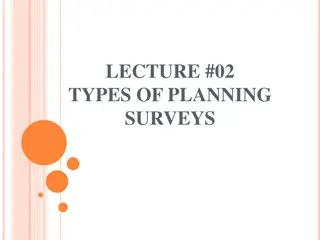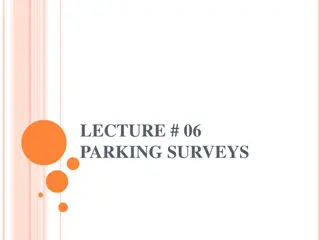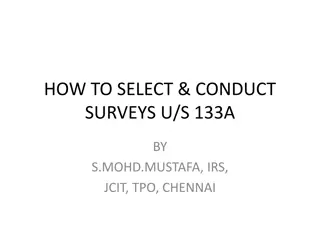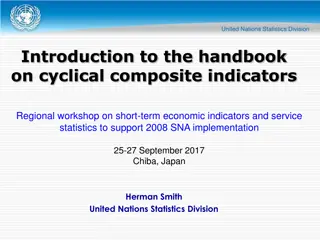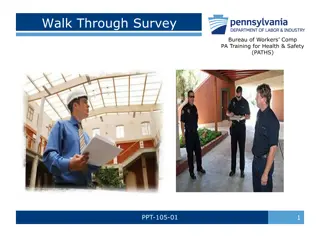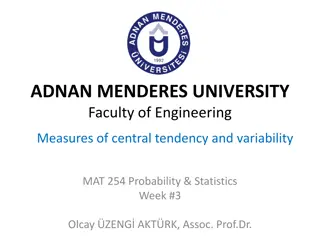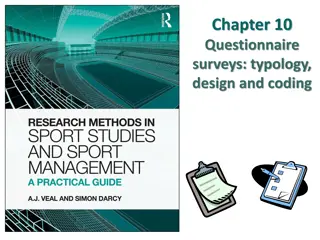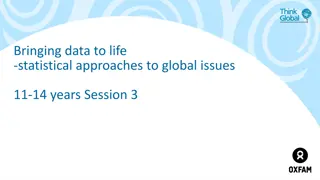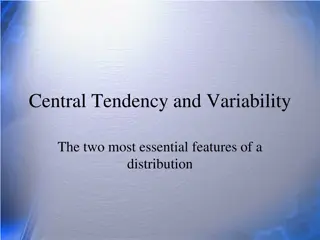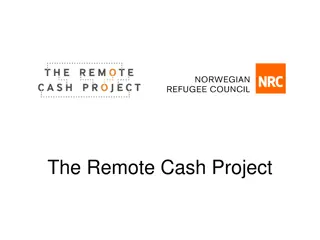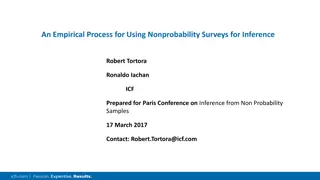Handbook on Economic Tendency Surveys: Best Practices and Principles
This presentation highlights the Handbook on Economic Tendency Surveys, covering topics such as sample selection, questionnaire design, data processing, and dissemination of results. It outlines the objectives, preparation process, and importance of economic tendency surveys in capturing assessments of past, current, and future business and consumer trends. The establishment of a working group and global consultations demonstrate the collaborative effort to create a comprehensive guide for implementing these surveys effectively.
Download Presentation

Please find below an Image/Link to download the presentation.
The content on the website is provided AS IS for your information and personal use only. It may not be sold, licensed, or shared on other websites without obtaining consent from the author.If you encounter any issues during the download, it is possible that the publisher has removed the file from their server.
You are allowed to download the files provided on this website for personal or commercial use, subject to the condition that they are used lawfully. All files are the property of their respective owners.
The content on the website is provided AS IS for your information and personal use only. It may not be sold, licensed, or shared on other websites without obtaining consent from the author.
E N D
Presentation Transcript
Economic Tendency Surveys Regional workshop on short-term economic indicators and service statistics to support 2008 SNA implementation 25-27 September 2017 Chiba, Japan Herman Smith United Nations Statistics Division
Objectives of the presentation Provide an overview of the Handbook Background Overview Status of preparation Tendency Surveys Frequency Questionnaire Answering scheme Data collection methods Data processing Metadata and data dissemination 2
Handbook on Economic Tendency Survey Economic Tendency Surveys They are tools used to capture an assessment of the past situation, current situation and expectations on future developments of business and/or consumers. They are an integral part of an early warning system because they provide information about the occurrence and timing of upturns and downturns of the economy. 3
Handbook on Economic Tendency Survey The objective of the Handbook To provide best practices and harmonized principles on tendency survey covering aspects such as: sample selection; questionnaire design; survey questions; survey execution; data processing; dissemination of results; and use of the results of tendency surveys. 4
Handbook on Economic Tendency Survey Preparation process A working group was established in 2012: The Italian National Statistical Institute (ISTAT) (lead institution) The KOF Swiss Economic Institute Statistics Netherlands (CBS) Philippine Statistical Authority The Organisation for Economic Co-operation and Development (OECD) UNSD A draft was prepared and reviewed by experts during the period January 2013 - May 2014 5
Handbook on Economic Tendency Survey Preparation process 28 July- 29 August 2014: Global Consultation with countries, international/regional organizations, and other relevant institutions took place during the period Responses: 65 responses were received Overall there was a strong support for the Handbook: the responses were extremely positive and a number of useful comments were received. Summary report is available at: http://unstats.un.org/unsd/nationalaccount/gcItemETS.asp 6
Handbook on Economic Tendency Survey Preparation process October 2014 - March 2015: revisions of the draft by ISTAT and UNSD May-June 2015: final review by the working group Summer 2015: submission for publication The handbook is available online at: https://unstats.un.org/unsd/nationalaccount/docs/ET S_Handbook_Final.pdf Consultative and transparent drafting process! 7
Outline of the Handbook Chapter 1: Introduction Chapter 2: Scope of Economic Tendency surveys Chapter 3: The questionnaire design Chapter 4: Survey frame and sample design Chapter 5: Estimation procedures and accuracy Chapter 6: Data collection Chapter 7: Managing sources of non-sampling errors Chapter 8: Processing tendency survey data Chapter 9: Data dissemination and publication Chapter 10: Use of tendency survey results 9
The Handbook is based on existing work by international/regional organizations and countries experience: Joint Harmonized EU Programme of Business and Consumer Surveys (Directorate-General for Economic and Financial Affairs) Business Tendency Surveys - A Handbook (OECD) Country experience compiling these surveys 10
What are tendency surveys? Surveys aimed at collecting (mainly qualitative) information on the assessment of the current and future economic situation. They are an important tool for economic monitoring, short-term forecasting and economic research. Main features of tendency surveys: Simplicity of the questionnaire Assessment mainly provided through qualitative responses Frequency and timeliness of the responses 11
Historical development 1920s Some countries started conducting tendency surveys 1950s more countries implement these surveys (France, Germany, etc.) Centre for International Research on Economic Tendency Surveys (CIRET) was founded. CIRET is a forum for leading economists and institutions concerned with analysing and predicting the development of the business cycle and the economic and socio-political consequences. 2010s 1990s 1960s 1950s 1920s 12
Historical development 1960s The European Commission launched the Joint Harmonized EU Programme of Business and Consumer Surveys 1990s The OECD started a programme on business tendency surveys 2010s Importance of tendency surveys acknowledged at international level 2010s 1990s 1960s 1950s 1920s 13
Uses of tendency surveys They provide source of information for: Economic surveillance Calculate composite indicators (e.g. Consumer confidence indicators, etc.) Input variables for forecasting (nowcasting) Economic research 14
Comparison with quantitative statistics Main differences: Qualitative vs quantitative responses Time of release Perception vs objective measures/levels Tendency surveys are not a substitute for quantitative data, but rather they complement such data. The fact that the series move together gives credibility to both data sets 15
Types of tendency surveys Business tendency surveys They are carried out among specific segments of the economy The target population: economic activities in the specific segment of the economy They ask for an assessment of the company s current and future situation and of the economy as a whole 16
Business tendency surveys Core economic activities: Manufacturing Construction Retail trade Services Economic activities of interest Agriculture Wholesale Financial Services ISIC Section C Manufacturing ISIC Section F Construction ISIC Division 45 and 47 ISIC Section H ISIC Section A Agri. forestry and fishing ISIC Division 46 Wholesale trade ISIC Section K Financial and insurance activities Economic activities classified according to the International Standard Classification of All Economic Activities, ISIC Rev. 4 17
Business tendency surveys Factors that affect the choice of the economic activities to cover: Contribution to the overall economy Cyclicality Control by the Government Sector 18
Consumer tendency surveys Consumer tendency surveys The are carried out among consumers Target population: adult population in a country They ask for an assessment of the past, current and future economic situation of the household and of the country 19
Frequency of tendency surveys The choice of the frequency of the surveys is the result of a trade-off between the availability of resources and the need for timely signal on economic development They are generally conducted on a monthly basis Specific questions are asked on quarterly basis (e.g. factors limiting production, capacity utilizations, likelihood to buy a car, etc.) and semi-annual basis (e.g. investments). 20
Questionnaire Basic principles for the questionnaire design Questions measure business activity at an early stage (in order to timely capture business cycle developments); The topic of the questions should be sensitive to changes in the economic environment; Questions mainly focus on assessments, expectations and plans even though some quantitative information may be asked; The number of questions should also be kept to a minimum in order to reduce response burden. Respondents are asked to exclude seasonality. 21
Questionnaire Questionnaire includes a section on the characteristics of the respondents. Pre-testing of the questionnaire is particularly important. The Handbook provide a list of internationally agreed questions. Additional questions can be added by countries based on the specific situation. 22
Topics of the questions in Business Tendency Surveys Monthly Economic activities Past Future (3 months) Topic of the questions Present (3 months) x x x x Evolution of production Evolution of employment Level of order books Level of export order books Stock of finished goods Evolution of selling prices Evolution of building activity Evolution of employment Level of order books Factors limiting production Evolution of selling prices x x x Manufacturing x x x x x x x Construction x 23
Topics of the questions in Business Tendency Surveys Monthly Economic activities Past Future (3 months) Topic of the questions Present (3 months) Evolution of business activity(sales) x x Evolution of employment Evolution of orders placed with suppliers x x x Retail Trade Stock of finished goods Evolution of selling prices Evolution of business situation Evolution of employment Evolution of demand (turnover) Evolution of selling prices x x x x x x x x x Services 24
Topics of the questions in Business Tendency Surveys Quarterly Economic activities Subject Past Present Future (3 months) x x (3 months) x Evolution of order books Evolution of export order books Months of production assured by current order books Factors limiting production Production capacity Capacity utilisation Stock of raw materials Evolution of the competitive position on the domestic market Months of production assured by current order books Capacity utilisation x x x x x Manufacturing x x Construction x 25
Topics of the questions in Business Tendency Surveys Quarterly Economic Activities Subject Past Present Future (3 months) (3 months) x Factors limiting activity Services Increase of volume of activity with present resources x x x Evolution of operating income x x Evolution of operating expenses Financial Services x x Evolution of profitability x x Evolution of capital expenditure x x Evolution of competitive position 26
Topics of the questions in Consumer Tendency Surveys Monthly Subject Past Present Future (12 months) (12 months) Evolution of household financial situation Evolution of the general economic situation in the country Evolution of consumer prices Evolution of the number of unemployed people Right moment to make major purchases Evolution of money spent on major purchases Opportunity to save Statement best describing the household financial situation x x x x x x x x x x x x 27
Topics of the questions in Consumer Tendency Surveys Quarterly Subject Past Present Future (12 months) (12 months) Likelihood to buy a car Plans to buy or to build a home x x Likelihood to spend large sums of money on home improvements or renovations x 28
Measurement scale Multiple choice questions with possible answers on a (3- or 5-level) Likert scale Examples: A lot better A little better Same A little worse A lot worse Above normal Normal Below normal Increase Remain unchanged Decrease 29
Data collection Business tendency surveys Consumer tendency survey Target population All companies carrying out the specific kind of economic activity Business registers Adult individuals Sample frame Population registers; electoral rolls; phone registers Sample design Panel sample (with rotating panel) The sample design depends on the specific situation in the country. A review of the available sample design is provided in the handbook. Sample techniques are used to make inference on the population based on the sample and dealing with sampling and non-sampling errors. 30
Data processing Percentages for each reply option From Business Tendency Surveys - A Handbook (OECD 2003) 31
Data processing - Balance statistics For a 3 option answers, the balance is calculated as: ? = ? ? where Above normal (P) Normal Below normal (N) For a 5 option answers, the balance is calculated as: ? = ?? +1 2? 1 2? + ?? where A lot better A little better (P) Same A little worse (N) A lot worse (PP) (NN) 32
Data processing Diffusion index The Diffusion Index is calculated as: ?? =1 2100 ? From Business Tendency Surveys - A Handbook (OECD 2003) 33
Data processing Other methods Probabilistic methods They assume a probability distribution of the opinion of the respondents Regression methods They assume that respondents implicitly attach a quantitative variable to each qualitative option Latent factors models They assume a latent variable behind each qualitative reply 34
Data processing Choice of the quantification methods Percentages Balances Diffusion index For presentation of the results and calculation of composite indicators Probabilistic methods Regression methods Latent factors models For business cycle analyses and economic modelling 35
Metadata and Data Dissemination It is important to provide metadata when disseminating the results of tendency surveys. Contact data Country Survey Organization Official address Website Contact person Methodology Survey frame Size of frame list Characteristics Frame list update Population Sampling method Sample size Sampling error Response rate Treatment of non-responses Sample coverage Weighting scheme Kinds of economic activities Periodicity Survey method Fieldwork period Remarks methodology Data and dissemination Type of data Unit of measure Data revision Frequency of dissemination Dissemination format Release policy Metadata update 36
Metadata and Data Dissemination Important considerations on data dissemination: Release calendar Confidentiality Revision policy Press release 37
Thank you sna@un.org 38
